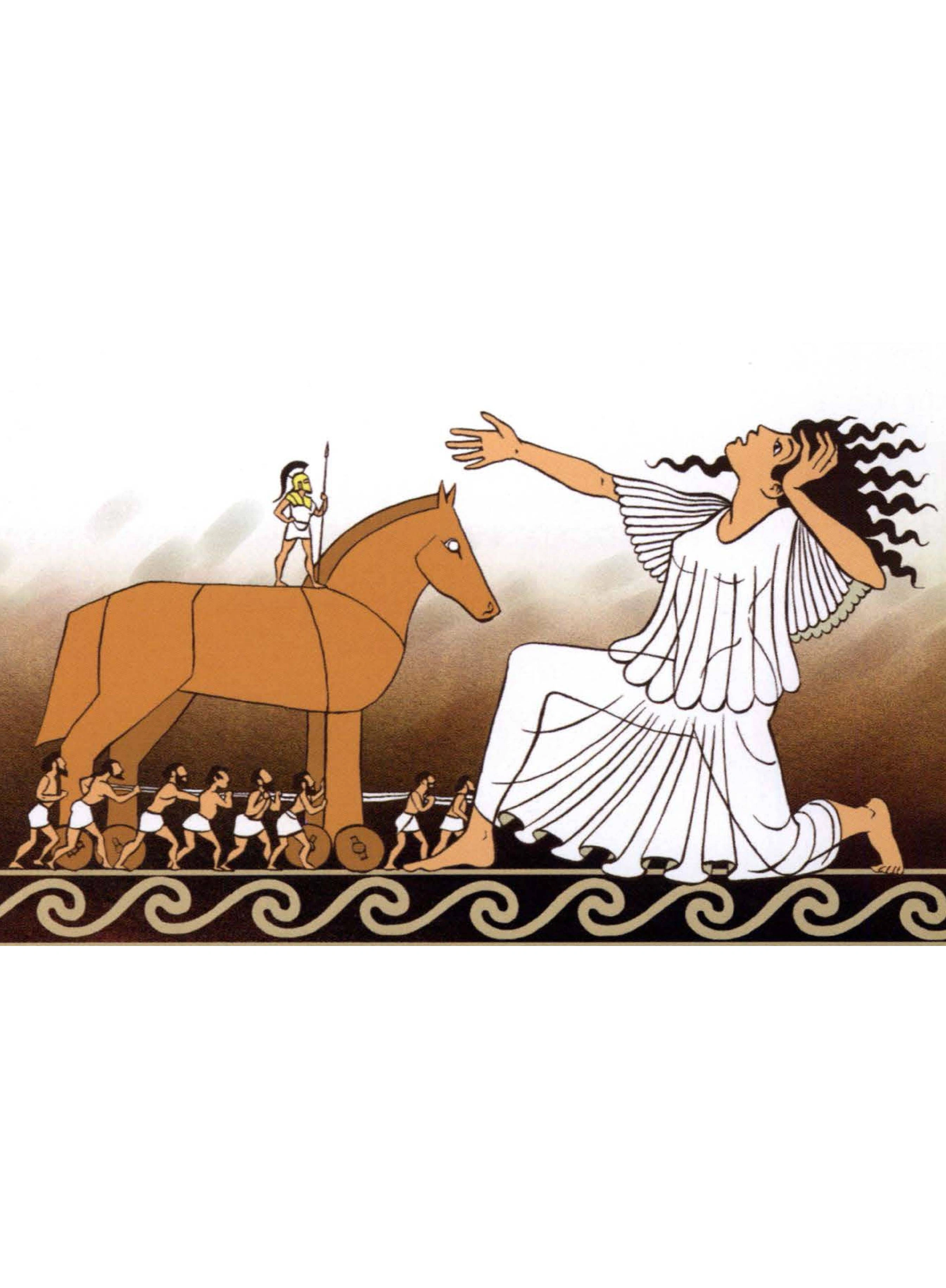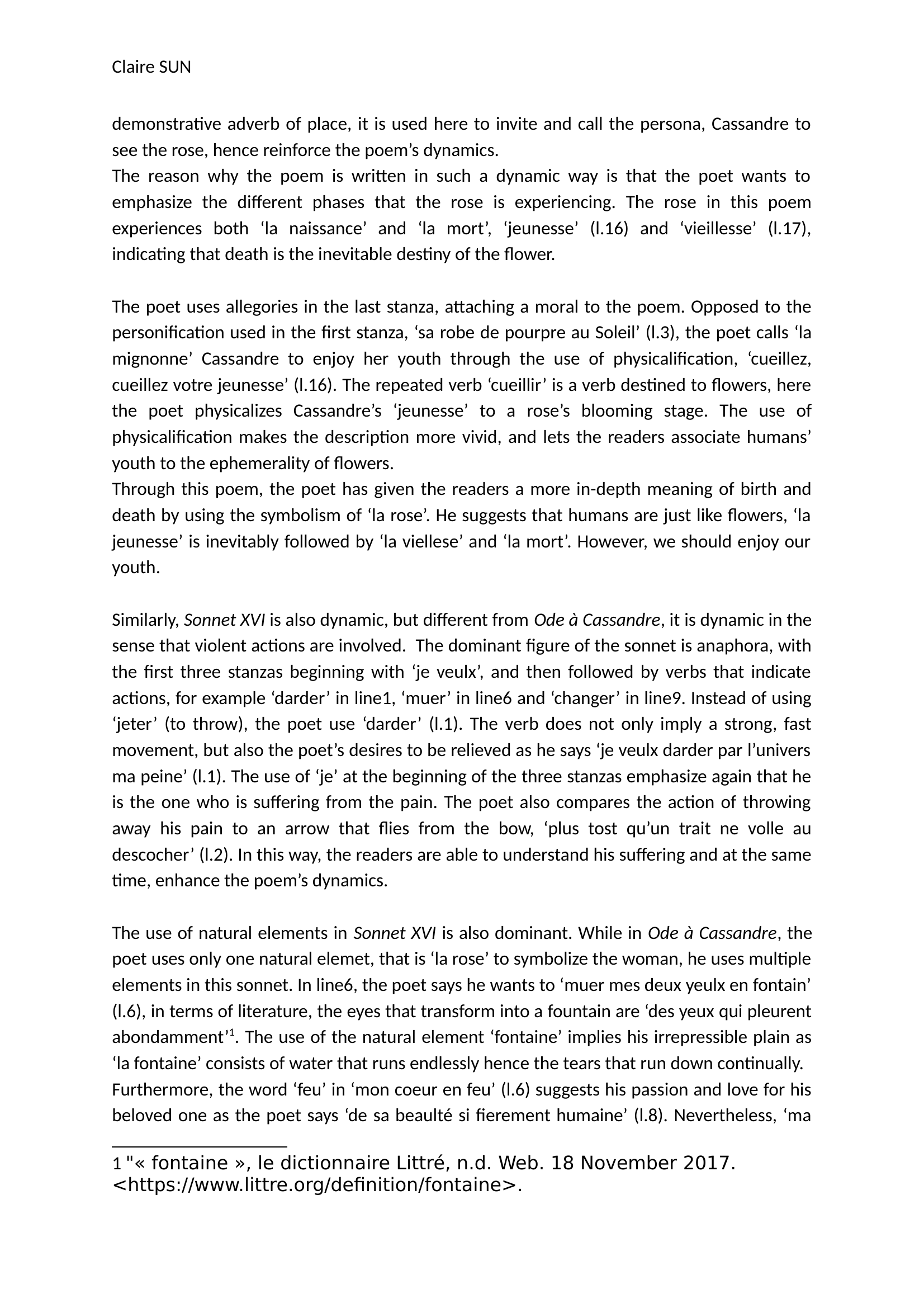?Commentary on Ode à Cassandre and Sonnet XVI Ode
Publié le 28/01/2019
Extrait du document


«
Claire SUN
demonstrative adverb of place, it is used here to invite and call the persona, Cassandre to
see the rose, hence reinforce the poem’s dynamics.
The reason why the poem is written in such a dynamic way is that the poet wants to
emphasize the different phases that the rose is experiencing.
The rose in this poem
experiences both ‘la naissance’ and ‘la mort’, ‘jeunesse’ (l.16) and ‘vieillesse’ (l.17),
indicating that death is the inevitable destiny of the flower.
The poet uses allegories in the last stanza, attaching a moral to the poem.
Opposed to the
personification used in the first stanza, ‘sa robe de pourpre au Soleil’ (l.3), the poet calls ‘la
mignonne’ Cassandre to enjoy her youth through the use of physicalification, ‘cueillez,
cueillez votre jeunesse’ (l.16).
The repeated verb ‘cueillir’ is a verb destined to flowers, here
the poet physicalizes Cassandre’s ‘jeunesse’ to a rose’s blooming stage.
The use of
physicalification makes the description more vivid, and lets the readers associate humans’
youth to the ephemerality of flowers.
Through this poem, the poet has given the readers a more in-depth meaning of birth and
death by using the symbolism of ‘la rose’.
He suggests that humans are just like flowers, ‘la
jeunesse’ is inevitably followed by ‘la viellese’ and ‘la mort’.
However, we should enjoy our
youth.
Similarly, Sonnet XVI is also dynamic, but different from Ode à Cassandre , it is dynamic in the
sense that violent actions are involved.
The dominant figure of the sonnet is anaphora, with
the first three stanzas beginning with ‘je veulx’, and then followed by verbs that indicate
actions, for example ‘darder’ in line1, ‘muer’ in line6 and ‘changer’ in line9.
Instead of using
‘jeter’ (to throw), the poet use ‘darder’ (l.1).
The verb does not only imply a strong, fast
movement, but also the poet’s desires to be relieved as he says ‘je veulx darder par l’univers
ma peine’ (l.1).
The use of ‘je’ at the beginning of the three stanzas emphasize again that he
is the one who is suffering from the pain.
The poet also compares the action of throwing
away his pain to an arrow that flies from the bow, ‘plus tost qu’un trait ne volle au
descocher’ (l.2).
In this way, the readers are able to understand his suffering and at the same
time, enhance the poem’s dynamics.
The use of natural elements in Sonnet XVI is also dominant.
While in Ode à Cassandre , the
poet uses only one natural elemet, that is ‘la rose’ to symbolize the woman, he uses multiple
elements in this sonnet.
In line6, the poet says he wants to ‘muer mes deux yeulx en fontain’
(l.6), in terms of literature, the eyes that transform into a fountain are ‘des yeux qui pleurent
abondamment’ 1
.
The use of the natural element ‘fontaine’ implies his irrepressible plain as
‘la fontaine’ consists of water that runs endlessly hence the tears that run down continually.
Furthermore, the word ‘feu’ in ‘mon coeur en feu’ (l.6) suggests his passion and love for his
beloved one as the poet says ‘de sa beaulté si fierement humaine’ (l.8).
Nevertheless, ‘ma
1 "« fontaine », le dictionnaire Littré, n.d.
Web.
18 November 2017.
..
»
↓↓↓ APERÇU DU DOCUMENT ↓↓↓
Liens utiles
- Pierre de RonsardOde à CassandreMignonne, allons voir si la roseQui ce matin avait décloseSa robe de pourpre au soleil,A point perdu, cette vêprée,Les plis de sa robe pourpréeEt son teint au vôtre pareil.
- Pierre de Ronsard Ode à Cassandre Mignonne, allons voir si la rose Qui ce matin avait déclose Sa robe de pourpre au soleil, A point perdu, cette vêprée, Les plis de sa robe pourprée Et son teint au vôtre pareil.
- ''Ode à Cassandre'' de Ronsard
- Commentary : Death and sexuality in Virgin suicides
- D'après ses odes : à la Fontaine Bellerie, à la forêt de Gastine, à son Sépulchre, à Cassandre (Mignonne, allons voir si la, rose...) déterminer les caractères de l'ode horatienne de Ronsard.

































